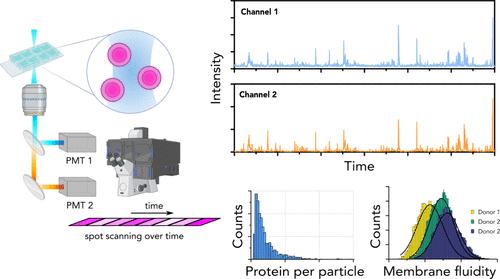用常规共聚焦显微镜成像单粒子剖面仪研究纳米级生物颗粒
IF 9.1
1区 材料科学
Q1 CHEMISTRY, MULTIDISCIPLINARY
引用次数: 0
摘要
单颗粒分析(SPP)是一种独特的方法来研究纳米级生物颗粒,如脂质体、脂质纳米颗粒、细胞外囊泡和脂蛋白在单颗粒和高通量的方式。最初的版本需要单光子计数模块进行数据采集,这限制了它的可接受性。在这里,我们提出了基于成像的SPP (iSPP),可以通过在共聚焦探测器的共同成像模式下对一个点进行随时间的成像来完成。我们还提供具有图形用户界面的用户友好软件来分析这些数据,并对纳米级生物颗粒的含量和特性进行定量分析。我们使用iSPP来破译脂质-蛋白相互作用,药物对膜的修饰,以及从细胞系和人类尿液中分离的细胞外囊泡的异质性。这种易于应用的单粒子剖面仪将有助于在实验室中使用任何共聚焦显微镜进行纳米级生物颗粒研究。本文章由计算机程序翻译,如有差异,请以英文原文为准。

Imaging Single Particle Profiler to Study Nanoscale Bioparticles Using Conventional Confocal Microscopy
Single particle profiling (SPP) is a unique methodology to study nanoscale bioparticles such as liposomes, lipid nanoparticles, extracellular vesicles, and lipoproteins in a single particle and high throughput manner. The initial version requires the single photon counting modules for data acquisition, which limits its adoptability. Here, we present imaging-based SPP (iSPP) that can be performed by imaging a spot over time in the common imaging mode with confocal detectors. We also provide user-friendly software with a graphical user interface to analyze such data and give quantitative insights on the content and properties of nanoscale bioparticles. We use iSPP to decipher lipid–protein interactions, membrane modifications by drugs, and the heterogeneity of extracellular vesicles isolated from cell lines and human urine. This easily applicable modality of the single particle profiler will facilitate nanoscale bioparticle research in laboratories with access to any confocal microscope.
求助全文
通过发布文献求助,成功后即可免费获取论文全文。
去求助
来源期刊

Nano Letters
工程技术-材料科学:综合
CiteScore
16.80
自引率
2.80%
发文量
1182
审稿时长
1.4 months
期刊介绍:
Nano Letters serves as a dynamic platform for promptly disseminating original results in fundamental, applied, and emerging research across all facets of nanoscience and nanotechnology. A pivotal criterion for inclusion within Nano Letters is the convergence of at least two different areas or disciplines, ensuring a rich interdisciplinary scope. The journal is dedicated to fostering exploration in diverse areas, including:
- Experimental and theoretical findings on physical, chemical, and biological phenomena at the nanoscale
- Synthesis, characterization, and processing of organic, inorganic, polymer, and hybrid nanomaterials through physical, chemical, and biological methodologies
- Modeling and simulation of synthetic, assembly, and interaction processes
- Realization of integrated nanostructures and nano-engineered devices exhibiting advanced performance
- Applications of nanoscale materials in living and environmental systems
Nano Letters is committed to advancing and showcasing groundbreaking research that intersects various domains, fostering innovation and collaboration in the ever-evolving field of nanoscience and nanotechnology.
 求助内容:
求助内容: 应助结果提醒方式:
应助结果提醒方式:


